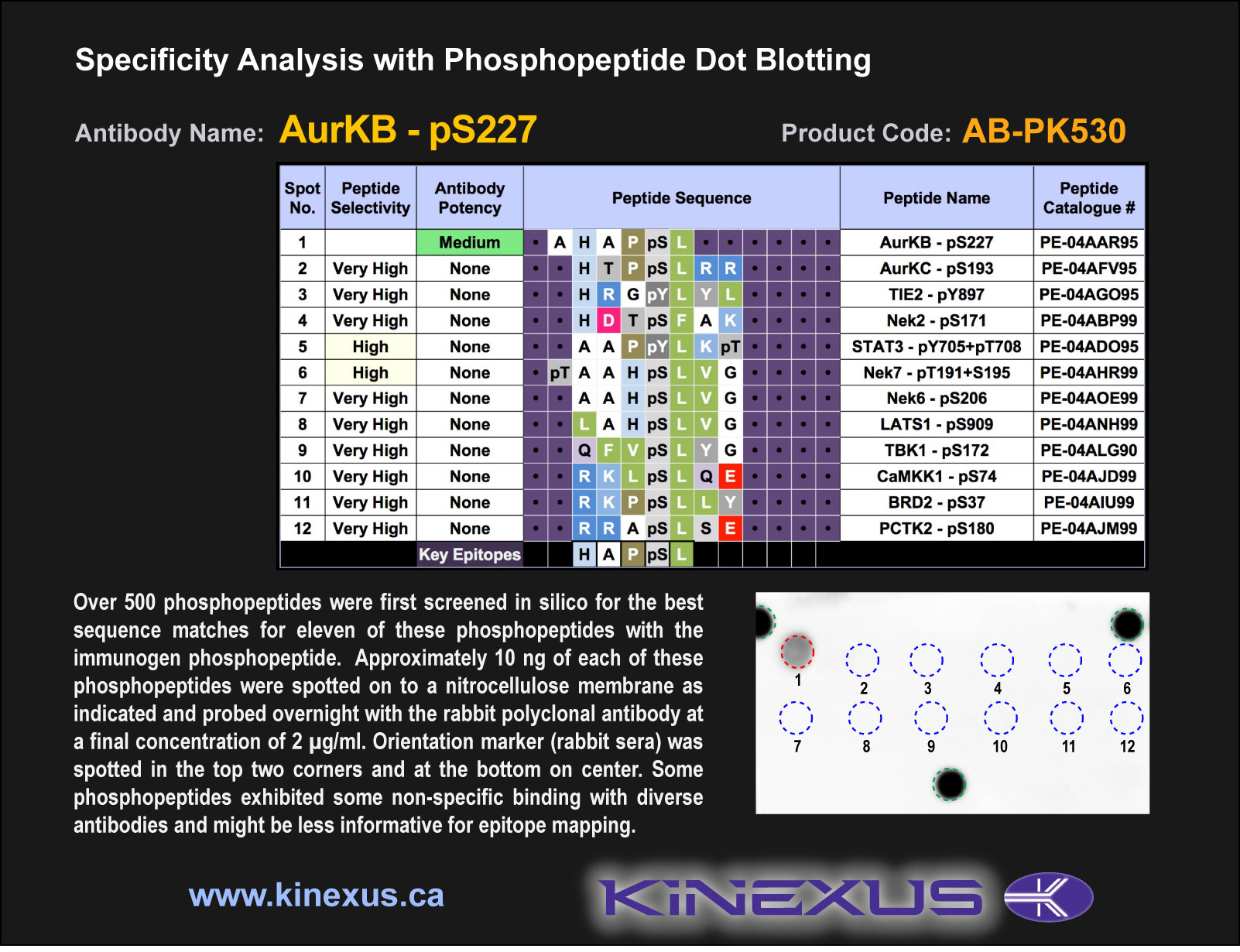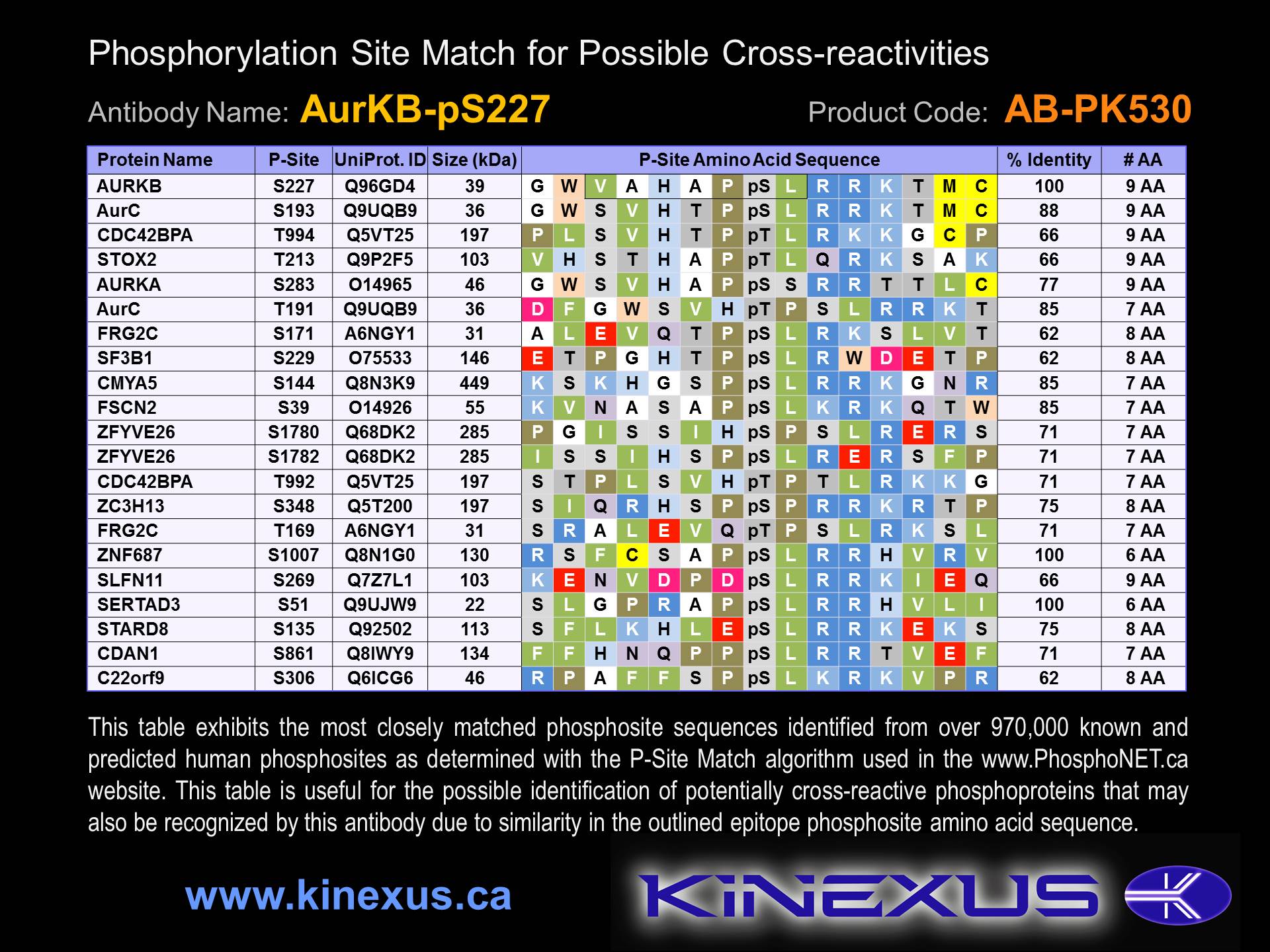Product Name: AurKB-pS227
Product Number: AB-PK530
| Size: | 25 µg | Price: | 89.00 | |
| $US |
Target Full Name: Aurora Kinase B (serine/threonine protein kinase 12)
Target Alias: AIK2; AIM1; AIM-1; ARK2; AurkB; Aurora,IPL1-related kinase 2; Aurora-2; Aurora-B; STK12; AurkB; IPL1; STK12; STK5; CCDS11134.1; ENSG00000178999
Product Type Specific: Protein kinase phosphosite-specific antibody
Antibody Code: PK530
Antibody Target Type: Phosphosite-specific
Antibody Phosphosite: S227
Protein UniProt: Q96GD4
Protein SigNET: Q96GD4
Antibody Type: Polyclonal
Antibody Host Species: Rabbit
Target Alias: AIK2; AIM1; AIM-1; ARK2; AurkB; Aurora,IPL1-related kinase 2; Aurora-2; Aurora-B; STK12; AurkB; IPL1; STK12; STK5; CCDS11134.1; ENSG00000178999
Product Type Specific: Protein kinase phosphosite-specific antibody
Antibody Code: PK530
Antibody Target Type: Phosphosite-specific
Antibody Phosphosite: S227
Protein UniProt: Q96GD4
Protein SigNET: Q96GD4
Antibody Type: Polyclonal
Antibody Host Species: Rabbit
Antibody Immunogen Source: Human AurKB (Aurora B, AIM-1) sequence peptide Cat. No.: PE-04AAR95
Antibody Immunogen Sequence: VAHAP(pS)L(bA)C
Antibody Immunogen Description: Corresponds to amino acid residues V222 to L228; In the protein kinase catalytic domain activation T loop region between subdomains VII and VIII.
Antibody Immunogen Sequence: VAHAP(pS)L(bA)C
Antibody Immunogen Description: Corresponds to amino acid residues V222 to L228; In the protein kinase catalytic domain activation T loop region between subdomains VII and VIII.
Production Method: The immunizing peptide was produced by solid phase synthesis on a multipep peptide synthesizer and purified by reverse-phase hplc chromatography. Purity was assessed by analytical hplc and the amino acid sequence confirmed by mass spectrometry analysis. This peptide was coupled to KLH prior to immunization into rabbits. New Zealand White rabbits were subcutaneously injected with KLH-coupled immunizing peptide every 4 weeks for 4 months. The sera from these animals was applied onto an agarose column to which the immunogen peptide was thio-linked. Antibody was eluted from the column with 0.1 M glycine, pH 2.5. Subsequently, the antibody solution was neutralized to pH 7.0 with saturated Tris.This antibody was also subject to negative purification over phosphotyrosine-agarose.
Antibody Modification: Unconjugated. Contact KInexus if you are interest in having the antibody biotinylated or coupled with fluorescent dyes.
Antibody Modification: Unconjugated. Contact KInexus if you are interest in having the antibody biotinylated or coupled with fluorescent dyes.
Antibody Concentration: 1 mg/ml
Storage Buffer: Phosphate buffered saline pH 7.4, 0.05% Thimerasol
Storage Conditions: For long term storage, keep frozen at -40°C or lower. Stock solution can be kept at +4°C for more than 3 months. Avoid repeated freeze-thaw cycles.
Product Use: Western blotting | Antibody microarray
Antibody Dilution Recommended: 2 µg/ml for immunoblotting
Antibody Potency: Medium immunoreactivity of a target-sized protein by Western blotting in sea star oocyte. Very strong immunoreactivity with immunogen peptide on dot blots.
Antibody Species Reactivity: Human
Storage Buffer: Phosphate buffered saline pH 7.4, 0.05% Thimerasol
Storage Conditions: For long term storage, keep frozen at -40°C or lower. Stock solution can be kept at +4°C for more than 3 months. Avoid repeated freeze-thaw cycles.
Product Use: Western blotting | Antibody microarray
Antibody Dilution Recommended: 2 µg/ml for immunoblotting
Antibody Potency: Medium immunoreactivity of a target-sized protein by Western blotting in sea star oocyte. Very strong immunoreactivity with immunogen peptide on dot blots.
Antibody Species Reactivity: Human
Antibody Positive Control: The observed molecular mass of the processed target protein on SDS-PAGE gels is reported to be around 35-45 kDa.
Antibody Specificity: High
Antibody Cross Reactivity: Weak immunoreactivity on protein dot blots with recombinant human AurKC, but no immunoreactivity with AurKA. No cross-reactive proteins detected in A549 and HeLa cells. A strong 36 kDa cross-reactive protein was detected in sea star oocytes, and a strong 28 kDa cross-reactive protein in Jurkat cells.
Related Product 1: AurKB-pS227 blocking peptide
Related Product 2: AurKB pan-specific antibody (Cat. No.: AB-NK193-2P)
Related Product 3: AurKB-1 pan-specific antibody (Cat. No.: AB-NK193-2)
Antibody Specificity: High
Antibody Cross Reactivity: Weak immunoreactivity on protein dot blots with recombinant human AurKC, but no immunoreactivity with AurKA. No cross-reactive proteins detected in A549 and HeLa cells. A strong 36 kDa cross-reactive protein was detected in sea star oocytes, and a strong 28 kDa cross-reactive protein in Jurkat cells.
Related Product 1: AurKB-pS227 blocking peptide
Related Product 2: AurKB pan-specific antibody (Cat. No.: AB-NK193-2P)
Related Product 3: AurKB-1 pan-specific antibody (Cat. No.: AB-NK193-2)
Related Product 4: AurKB-2 pan-specific antibody (Cat. No.: AB-NK193-3)
Related Product 5: AurKB-3 pan-specific antibody (Cat. No.: AB-NK193-4)
Related Product 6: AurKB-pT232 phosphosite-specific antibody (Cat. No.: AB-PK531)
Related Product 5: AurKB-3 pan-specific antibody (Cat. No.: AB-NK193-4)
Related Product 6: AurKB-pT232 phosphosite-specific antibody (Cat. No.: AB-PK531)
Scientific Background: AurB (AurKB, AIK2) is a protein-serine/threonine kinase of the Other group and AUR family. It serves as a component of the chromosomal passenger complex (CPC) that plays a critical role in regulating mitosis. AurB may be a tumour requiring protein (TRP). Its low rate of mutation and down-regulation in human cancers supports it identification as a tumour-requiring protein, and as a target for cancer drug development. However, AurB is overexpressed in some colorectal cancers and other tumour cell lines, which was thought to lead to multinuclearity, increased ploidy, and a predisposition to cancer. Through its dominant-negative effect on cytokinesis, disruptive regulation of its expression is potentially responsible for the perturbing the chromosomal integrity in cancer cells. A K106R mutation leads to loss of phosphotransferase activity, and severely impairs mitosis.
Figure 1. Epitope mapping of AurKB-pS227 antibody with similar phosphopeptides on dot blots.
Figure 2. Identification of phosphosites related to AurKB-pS227.
© Kinexus Bioinformatics Corporation 2017



